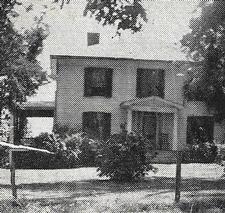Ashworth/Dade House

Ashworth Home is Notable Landmark of Springfield
"Reposing amid a grove of lofty maples and poplars, the house shown here, one of the landmarks of Springfield, is the home of Mrs. John W. Ashworth, West Mt. Vernon Street, and marks the site on which the first schoolhouse in Greene County was built.
"The building, a log cabin, was erected in 1831 by pioneers two years after the founding of Springfield. The cabin, of two or three rooms, had for windows and entrances merely openings hewn from the logs. It had no doors or shutters, a dirt floor and three legged benches on which the sons and daughters of the early pioneers sat as they worked their problems. Within the walls of this crude hut Springfield’s first ‘younger generation’ learned the fundamentals of citizenship; here was the beginning of Springfield’s public school system which after a century’s progress has grown to an institution supported by a $1,500,000 public bond issue.
"Springfield’s first school master was Joseph Fulbright, one of the first settlers of the town. In contrast to the tens of thousands of children now enrolled in the public schools here, his class was made up of about a dozen children of the Rountree, Weaver, Miller, and Fulbright families, who had settled on the land surrounding the cabin.
"A stone monument, erected in 1921 by the University Club of this city, now marks the site of the old school. The property now belongs to Mrs. Ashworth, who is the granddaughter of John W. Mack, one of the first settlers in the region.
"Mrs. Ashworth, who spent her girlhood there, recalls the days when the valley, sweeping away from the hillside on which the house stands, was one of the most beautiful in the region. The Jordan River, now a source of much concern to officials of the city, was then a picturesque stream, it’s bank lined with wild roses and dewberries. Its pools, hidden in the shade of elms and poplars, were the haven for youthful fishermen and picnic parties. Around a bend it widened, forming a pool where summer days were idled away in swimming and fishing.
"Town, during Mrs. Ashworth’s girlhood, was a mile and a half away. The trail led over a rustic bridge covered with ivy and honeysuckle and through shady groves of trees. In the springtime the entire valley was fragrant with wild flowers and apple blossoms.
"Time has brought changes to the valley but the summit of the hill with an avenue of elms and maples, leading to the house, is a remnant of the romantic valley and hillside.
"The house as far as is known was the first to be built here after the Civil War and is one of the best preserved landmarks in Springfield. Several cannon pits on the lawn and hillside nearby are silent evidence of the conflict.
"When the house was erected, by Dabney C. Dade, the hilltop was bare and treeless. Rows of poplars and soft maples and elms were set out and now have reached their full growth, and are considered some of the finest in Springfield. Some of them are five feet in diameter and almost one hundred feet high. A silver leaf poplar, in the fork of which a wooden seat was placed, has grown until its nearly 20 feet around the base. The wooden seat, on which children played in the summer afternoons, gradually ascended as the tree grew until it is now far out of reach and almost lost from sight.
"Mrs. Ashworth, who has observed the changes brought in the old hills and valleys of the Jordan, has expressed her sentiments in lines called the ‘House on the Hill.’"[The poem was not reproduced in the newspaper.]Springfield Press June 17, 1929.
The photograph of the Ashworth House is from the August 1961, Ozarks Mountaineer and is similar to the photo that was printed in the newspaper. The caption in the Mountaineer says the home was used as a hospital during the Civil War though this article says it was built after the Civil War.
For images of the historical marker mentioned and others visit Historical Markers of Springfield and Greene County, Missouri.
Find this article at